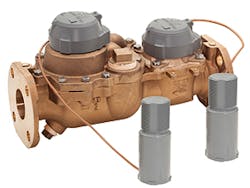Besides being critical for asset management and minimizing non-revenue water, the integration of GIS and AMI can be an overall “game changer” for operations for many utilities. “Neptune Technology Group introduced its GIS module in late 2014,” says John Sala, director of marketing. “As an AMI vendor, we use GIS-type information as part of what we do when we develop AMI solutions,” continues Sala. “We also use GIS information to help support our customers within our applications. The GIS component really helps us when we are working with utilities to implement AMI.”
Sala shared a number of the benefits of the integration:
- Leaks: Various outside factors can contribute to leaks, such as water quality and pressure. So, since Neptune meters can capture leak events at 15-minute intervals, you can overlay these leak events on a GIS map to see if there are any geographic relationships. The GIS overlay can also help coordinate any inspections that will likely result to make the most effective use of the field technician’s time. Kind of a one-two-punch
from the GIS integration.
- Leaks: Various outside factors can contribute to leaks, such as water quality and pressure. So, since Neptune meters can capture leak events at 15-minute intervals, you can overlay these leak events on a GIS map to see if there are any geographic relationships. The GIS overlay can also help coordinate any inspections that will likely result to make the most effective use of the field technician’s time. Kind of a one-two-punch from the GIS integration.
- Backflow: Neptune meters can detect backflow. “Backflow can happen for some innocuous reasons, such as in a very tight home where a water heater cycles when no one is using water, pushing some water back out of the house as a result of thermal expansion,” says Sala. “That’s not too important. In other cases, though, backflow can be important, such as a major line break that hasn’t been reported yet, which is causing negative pressure upstream.” Then, when someone opens a faucet, it can create a reverse flow of water. In addition, Neptune’s radios work with acoustic leak loggers that can be installed on distribution lines. They can alert the utility of a possible distribution line leak. If these don’t happen to be lined up all on the same street, you may assume these are independent, non-related, and non-importantinstances. However, by being connected to the GIS system, it will show the lines, laterals, and entities. If you overlay the distribution, you may find that there is an actual common line, because sometimes lines don’t run down the middle of a single street. When you overlay this, the line that does connect them becomes visible, and you can see the geocoded meters that are having backflow events that are all on that same line. “This lets you know that you need to go out and begin looking for the leak that is causing all of those problems, before it blows a hole in the road or floods something,” he says. “In other words, you want to ‘roll a truck’ to do repair proactively when possible, using the AMI intelligence for your preliminary investigation.”
- Backflow: Neptune meters can detect backflow. “Backflow can happen for some innocuous reasons, such as in a very tight home where a water heater cycles when no one is using water, pushing some water back out of the house as a result of thermal expansion,” says Sala. “That’s not too important. In other cases, though, backflow can be important, such as a major line break that hasn’t been reported yet, which is causing negative pressure upstream.” Then, when someone opens a faucet, it can create a reverse flow of water. In addition, Neptune’s radios work with acoustic leak loggers that can be installed on distribution lines. They can alert the utility of a possible distribution line leak. If these don’t happen to be lined up all on the same street, you may assume these are independent, non-related, and non-importantinstances. However, by being connected to the GIS system, it will show the lines, laterals, and entities. If you overlay the distribution, you may find that there is an actual common line, because sometimes lines don’t run down the middle of a single street. When you overlay this, the line that does connect them becomes visible, and you can see the geocoded meters that are having backflow events that are all on that same line. “This lets you know that you need to go out and begin looking for the leak that is causing all of those problems, before it blows a hole in the road or floods something,” he says. “In other words, you want to ‘roll a truck’ to do repair proactively when possible, using the AMI intelligence for your preliminary investigation.”
About the Author
William Atkinson
William Atkinson specializes in topics related to utilities and infrastructure.
Sign up for our eNewsletters
Get the latest news and updates

